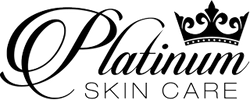Transitioning from Spa Peels to Home Peels
Posted by Jennifer Tilney on Dec 15, 2014

How to figure out which percentage of which acid you need to look your best!
Here is an all to common scenario. You had a peel at the spa during a facial about a week ago. Maybe someone got you a Gift Card last year and you had to use it before it expired. Great. You go in for your facial and the esthetician recommends a peel with your facial because you have (...fill in the blank...) wrong. You agree and have the peel. After some flaky bits for a few days you are stunned - your skin looks AMAZING! You want to do this all the time, but it is just too (...time consuming, expensive...). What are you going to do?
Buy a home peel - of course.
Now, there are definite Dangers involved with purchasing acids online. I am not going to talk about that here, but for your reference you can also read this blog post to be Safe while you choose your home peel. Rest assured, you are completely safe here at Platinum Skin Care.
Back to that life changing facial and peel. Do you even know what acid was applied to your face? The pH level or percentage? Not likely. Most estheticians like to keep their applications secret so you will NOT do exactly what you are trying to do now - Buy it elsewhere.
Well, here is what I have to say about that. There are people who feel comfortable doing a peel at home and there are people who will never feel comfortable. There are plenty to go around so every esthetician is busy and we are too. Even if you don't have to get your peels at the Spa, it is always a great idea to get a Facial every month or so - just because it is a great feeling to be taken care of and pampered every so often! Now, let's get back to deciphering what was on your face and what you should be doing at home. Shall we?
Most times acids are applied for a special reason.
Acids are proven workhorses. They have been used successfully for decades! And when you have a problem like: Acne, Pigmentation, Melasma, Wrinkles and Scarring, the peel is the #1 choice. Some acids are very versatile and can be used for many reasons. Think Glycolic. Great general acid for most minor troubles. But if you are dealing with melasma or problematic acne, then glycolic just isn't going to do the trick.
Which acid do I need?
Let's break things down generally by individual acids so you can get a good idea how the individual acids are used:
- Glycolic - Great water soluble acid. This is probably the most well known acid there is. The acid in "the Lunchtime Peel" that was so very popular once upon a time. It has a very small molecule for an alpha hydroxy acid and works well. Good for light exfoliation and refreshening of the skin. Softening fine lines is its forte'. Best for those with non-sensitive skin. If that retinol cream irritates you, then this is too strong. Try Mandelic!
- Salicylic - Oil soluble acid. The perfect choice for oily skin types and acne issues. Oil-loving salicylic will follow your sebum right down into your problematic pores. This acid can get right to the heart of the problem for pimple bearers. Salicylic is definitely irritating though, so if you are sensitive only use a very low percentage, or opt for another great acid like Mandelic or Azelaic.
- Lactic - Water loving acid. Lactic is hygroscopic. Meaning that it is hydrating. Best for sensitive skin types that are dry and pigmented. Not really an acid that shows a lot of "flaking" after a peel. A possibility of dryness for a few days with super light flaking. Best for those looking for moisture. Great for a weekly peel. Thin, dehydrated and pigmented skin (from all those years of sun bathing as a teen) then this will work well for you.
- Mandelic - This is probably the most rounded acid available in my opinion. Excellent for acne, wrinkles, pigmentation and more. Great for even sensitive skin types because of its large molecule. But does that mean it isn't a strong acid? Absolutely NOT! Mandelic is quite strong, it just has the benefit of being "comfortable". The best of both worlds if you ask me! When I think teens or sensitive adults, I think mandelic first. I won't lie - besides TCA, mandelic is my favorite acid.
- TCA - Trichloroacetic Acid is the "gold standard" to which all other acids are measured. One giant step down from phenol (phenol requires sedation, heart monitoring and is only performed by a doctor), TCA is the acid of choice when you are ready to make long lasting changes and stimulate collagen growth in the skin. It has a slightly different application than hydroxy acids. As opposed to a singular application, TCA is applied in layers. Each layer leading to more and deeper peeling. TCA is a perfect choice for deep pigmentation, scarring from previous acne bouts, stubborn acne, deeper lines and more. Many people like to use the Hydroxy Acids (Glycolic, Salicylic, Lactic, Mandelic) as a weekly peel, and then a few times per year do a great TCA peel for super changes. *TCA can be a mild one layer peel though, so do not be deterred from using it that way as well. TCA 13 is a super choice for most anti-aging challenges! I highly recommend it.
- Jessners - Consisting of lactic, salicylic and resorcinol, Jessners is yet another peel for acne skin types. Applied in multiple layers as with a TCA peel, the combination of acids works quite well for many people dealing with pimples. There are those that Love Jessners and those that feel it does nothing. Jessners is best left ON the skin for at least 3 hours after a peel application for best results. Vitamin A may be applied after the final layer as well.
- Progressive Peel - Combining salicylic, resorcinol, lactic, TCA and Vitamin A. Another powerhouse peel. You are basically combining all of the acids for one super peel. Excellent choice for those that have been "peeling" for awhile. Not a "newbie" peel. But when you are ready to be amazed, check back on this peel.
Something to remember here! Most Spas will not carry all of these acids. Many will only carry one or maybe two. You will probably find maybe a 30% of Glycolic and maybe a Jessners too. As we have learned above, there are reasons why we have so many acid choices. Because we are all special. We need those choices. You can find them here.
What strength do I want?
Irritation factor: Mild tingling to OMG stinging! What are you looking for? That's a trick question actually. Everyone deciphers the "feeling" of a peel differently. Put a 30% Glycolic on 5 people and ask them how it feels on a scale of 1-5. You will get five different answers! One person thinks its just water and the next thinks we are melting off their skin. That is the way it goes and there will always be a little bit of guessing when you first start your home peelings.
- Choose the acid you think will work best with your skin issues and your skin type from the acid choices.
- Do not try to compare percentages between the different acids as being the same. They are not. A TCA 30 can remove moles but a Glycolic 30 is the lowest strength available. See the differences between acids? *I will put a nice comparison chart below so you can see some relative similarities in strength.
- There will be various percentages available such as: Glycolic 30%, 50%, 70%. Always choose the lowest percentage! Again, absolutely always start off with the mildest formulation there is available. *Unless you know exactly what percentage of acid has been used on you in the spa, start low.
- Follow your directions exactly. Prepare your skin with daily acids or retinols to get the very best results from your peel. Heal and stay out of the sun. Protect your skin and enjoy the benefits of Home Peeling.
Understanding Strong Versus Weak Chemical Peels
I am borrowing this chart from an amazing page on our website that you should check out when you have the time. It answers all the great questions about chemical peels in extreme detail. You can find our Peel Information Page right here.
It can be confusing comparing different acids and their percentages, this is because a low percentage in one acid can actually be a great deal stronger than a higher percentage in another acid. Below is a chart showing the approximate increase in strength between them. Even though these different types of chemical peel acids are compared below, remember that everyone's skin is different and reacts differently. This chart can be used as a tool to help you decide what the best chemical peels for your skin are. And do not forget, we are here to help you if needed!
- 3% Salicylic
- 30% Glycolic, 50% Lactic, Mandelic Azelaic 22, and 13% TCA (at 1 layer)
- 50% Glycolic, 15% Salicylic and Mandelic 40% (without the comparable irritation)
- 25% Salicylic
- 70% Glycolic
- 20% TCA (1 layer) , Jessners (at 1-2 layers), Progressive Peel
- 30% TCA
I think it is time to start your Home Peeling adventure, don't you? If you still do not feel confident in choosing an acid or percentage, or you feel you have a special circumstance, we would love to hear from you and help you choose. We are here for you Monday through Friday from 9:00am - 5:00pm eastern standard time. Give us a call at 1-800-917-3155 or pop open the Chat box in the bottom corner - see it there? Give us a jingle so your skin can look amazing too.



